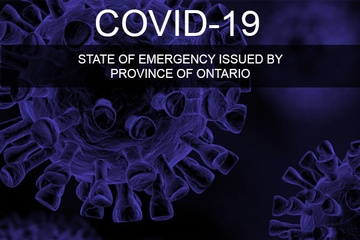How to protect yourself
Coronaviruses are spread mainly from person to person through close contact, for example, in a household, workplace or health care centre.
There is no vaccine available to protect against the 2019 novel coronavirus, but there are actions you can take to help prevent the spread of germs that cause respiratory illnesses.
Everyday actions
Take these everyday steps to reduce exposure to the virus and protect your health:
- wash your hands often with soap and water or alcohol-based hand sanitizer
- sneeze and cough into your sleeve
- avoid touching your eyes, nose or mouth
- avoid contact with people who are sick
- stay home if you are sick
Poster: What you need to know to help you and your family stay healthy
Physical distancing
Everyone in Ontario should be practicing physical distancing to reduce their exposure to other people.
Everyone in Ontario should do their best to avoid close contact with people outside of their immediate families. Close contact includes being within two (2) meters of another person.
If you believe you have been exposed to someone with COVID-19 symptoms, you should begin to self-monitor for a period of 14 days. This means that, in addition to physical distancing, you should track how you feel. You should take your temperature daily and log any other symptoms that develop (for example, sore throat, new cough). You can share these records with your primary care provider over the phone if you seek assessment services.
How to self-isolate
Self-isolating means staying at home and avoiding contact with other people to help prevent the spread of disease to others in your home and your community.
All persons over 70 years of age and individuals who are immunocompromised are advised to self-isolate for a period of 14 days. This means that you should only leave your home or see other people for essential reasons. Where possible, you should seek services over the phone or internet or ask for help from friends, family or neighbours with essential errands.
When self-isolating you should:
Stay home
- do not use public transportation, taxis or rideshares
- do not go to work, school or other public places
- your health care provider will tell you when it is safe to leave
Limit the number of visitors in your home
- only have visitors who you must see and keep the visits short
- keep away from seniors and people with chronic medical conditions (for example, diabetes, lung problems, immune deficiency)
Avoid contact with others
- stay in a separate room away from other people in your home as much as possible and use a separate bathroom if you have one
- make sure that shared rooms have good airflow (for example, open windows)
Keep distance
- if you are in a room with other people, keep a distance of at least two metres and wear a mask that covers your nose and mouth
- if you cannot wear a mask, people should wear a mask when they are in the same room as you
Cover your coughs and sneezes
- cover your mouth and nose with a tissue when you cough or sneeze
- cough or sneeze into your upper sleeve or elbow, not your hand
- throw used tissues in a lined waste basket, and wash your hands. Lining the wastebasket with a plastic bag makes waste disposal easier and safer.
- after emptying the wastebasket wash your hands
Wash your hands
- wash your hands often with soap and water
- dry your hands with a paper towel, or with your own cloth towel that no one else shares
- use an alcohol-based hand sanitizer if soap and water are not available
